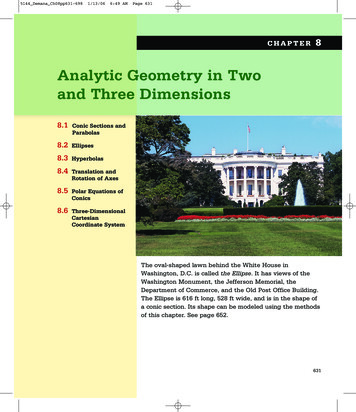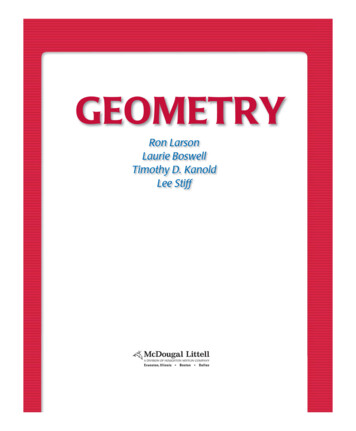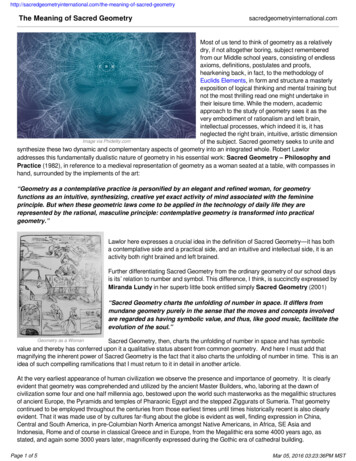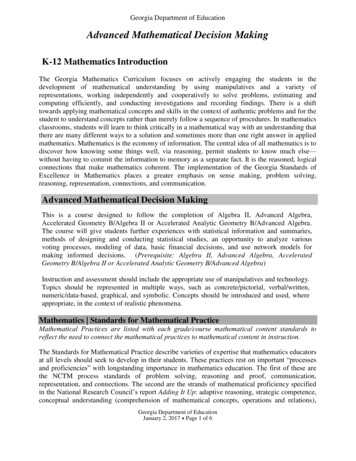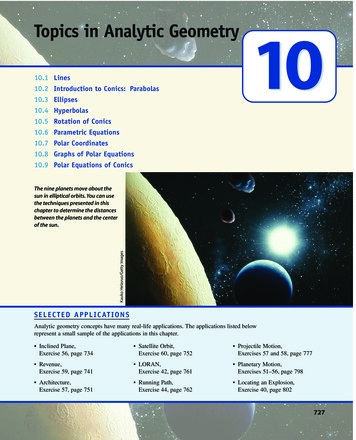
Transcription
Topics in Analytic ntroduction to Conics: ParabolasEllipsesHyperbolasRotation of ConicsParametric EquationsPolar CoordinatesGraphs of Polar EquationsPolar Equations of Conics10Kauko Helavuo/Getty ImagesThe nine planets move about thesun in elliptical orbits. You can usethe techniques presented in thischapter to determine the distancesbetween the planets and the centerof the sun.S E L E C T E D A P P L I C AT I O N SAnalytic geometry concepts have many real-life applications. The applications listed belowrepresent a small sample of the applications in this chapter. Inclined Plane,Exercise 56, page 734 Satellite Orbit,Exercise 60, page 752 Projectile Motion,Exercises 57 and 58, page 777 Revenue,Exercise 59, page 741 LORAN,Exercise 42, page 761 Planetary Motion,Exercises 51–56, page 798 Architecture,Exercise 57, page 751 Running Path,Exercise 44, page 762 Locating an Explosion,Exercise 40, page 802727
728Chapter 10Topics in Analytic Geometry10.1 LinesWhat you should learn Find the inclination of a line. Find the angle between twolines. Find the distance between apoint and a line.Why you should learn itThe inclination of a line canbe used to measure heightsindirectly. For instance, inExercise 56 on page 734, theinclination of a line can be usedto determine the change inelevation from the base to thetop of the Johnstown InclinedPlane.Inclination of a LineIn Section 1.3, you learned that the graph of the linear equationy mx bis a nonvertical line with slope m and y-intercept 0, b . There, the slope of a linewas described as the rate of change in y with respect to x. In this section, you willlook at the slope of a line in terms of the angle of inclination of the line.Every nonhorizontal line must intersect the x-axis. The angle formed bysuch an intersection determines the inclination of the line, as specified in thefollowing definition.Definition of InclinationThe inclination of a nonhorizontal line is the positive angle (less than )measured counterclockwise from the x-axis to the line. (See Figure 10.1.)yyyyθ 0θ π2xθθxxxAP/Wide World PhotosHorizontal LineFIGURE 10.1Vertical LineAcute AngleObtuse AngleThe inclination of a line is related to its slope in the following manner.Inclination and SlopeIf a nonvertical line has inclination and slope m, thenm tan .The HM mathSpace CD-ROM andEduspace for this text containadditional resources related to theconcepts discussed in this chapter.For a proof of the relation between inclination and slope, see Proofs inMathematics on page 806.
Section 10.1Lines729Finding the Inclination of a LineExample 1Find the inclination of the line 2x 3y 6.ySolutionThe slope of this line is m 23. So, its inclination is determined from theequation32tan .32x 3y 6From Figure 10.2, it follows that1θ 146.3 3 arctan x1FIGURE23 . This means that22 0.588 10.2 0.588 2.554.The angle of inclination is about 2.554 radians or about 146.3 .Now try Exercise 19.The Angle Between Two LinesyTwo distinct lines in a plane are either parallel or intersecting. If they intersectand are nonperpendicular, their intersection forms two pairs of opposite angles.One pair is acute and the other pair is obtuse. The smaller of these angles is calledthe angle between the two lines. As shown in Figure 10.3, you can use the inclinations of the two lines to find the angle between the two lines. If two lines haveinclinations 1 and 2, where 1 2 and 2 1 2, the angle between thetwo lines isθ θ 2 θ1θ 2 1.θ1FIGURE10.3θ2You can use the formula for the tangent of the difference of two anglesxtan tan 2 1 tan 2 tan 11 tan 1 tan 2to obtain the formula for the angle between two lines.Angle Between Two LinesIf two nonperpendicular lines have slopes m1 and m2, the angle between thetwo lines istan m2 m1.1 m1m2
730Chapter 10Topics in Analytic GeometryFinding the Angle Between Two LinesExample 2Find the angle between the two lines.yLine 1: 2x y 4 03x 4y 12 04Line 2: 3x 4y 12 0SolutionThe two lines have slopes of m1 2 and m2 34, respectively. So, the tangentof the angle between the two lines isθ 79.70 2tan 2x y 4 01x1FIGURE34 m2 m1 3 4 2 11 411 .1 m1m21 2 3 4 2 42Finally, you can conclude that the angle is arctan11 1.391 radians 79.70 2as shown in Figure 10.4.10.4Now try Exercise 27.The Distance Between a Point and a LineyFinding the distance between a line and a point not on the line is an applicationof perpendicular lines. This distance is defined as the length of the perpendicularline segment joining the point and the line, as shown in Figure 10.5.(x1, y1)Distance Between a Point and a LineThe distance between the point x1, y1 and the line Ax By C 0 isdd (x2, y2) Ax1 By1 C . A2 B2xFIGURERemember that the values of A, B, and C in this distance formula correspondto the general equation of a line, Ax By C 0. For a proof of the distancebetween a point and a line, see Proofs in Mathematics on page 806.10.5Example 3yFind the distance between the point 4, 1 and the line y 2x 1.43The general form of the equation is(4, 1)1x1 2 3 4FIGURESolutiony 2x 12 3 210.6Finding the Distance Between a Point and a Line2345 2x y 1 0.So, the distance between the point and the line isd 2 4 1 1 1 2 2 128 5 3.58 units.The line and the point are shown in Figure 10.6.Now try Exercise 39.
Section 10.1yExample 46B (0, 4)hSolutionC (5, 2)1x12345a. To find the altitude, use the formula for the distance between line AC and thepoint 0, 4 . The equation of line AC is obtained as follows.Slope: m 2FIGUREAn Application of Two Distance Formulasa. Find the altitude h from vertex B to side AC.b. Find the area of the triangle.2A ( 3, 0)731Figure 10.7 shows a triangle with vertices A 3, 0 , B 0, 4 , and C 5, 2 .54Lines2 02 1 5 3 8 410.71y 0 x 3 4Equation:4y x 3x 4y 3 0Point-slope formMultiply each side by 4.General formSo, the distance between this line and the point 0, 4 isAltitude h 1 0 4 4 3 12 4 213 17units.b. Using the formula for the distance between two points, you can find the lengthof the base AC to beb 5 3 2 2 0 2Distance Formula 82 22Simplify. 68Simplify. 2 17 units.Simplify.Finally, the area of the triangle in Figure 10.7 is1A bh2 Formula for the area of a triangle 113 2 17 172 13 square units.Substitute for b and h.Simplify.Now try Exercise 45.WRITING ABOUTMATHEMATICSInclination and the Angle Between Two Lines Discuss why the inclination of a linecan be an angle that is larger than 2, but the angle between two lines cannotbe larger than 2. Decide whether the following statement is true or false: “Theinclination of a line is the angle between the line and the x-axis.” Explain.
732Chapter 10Topics in Analytic Geometry10.1 ExercisesThe HM mathSpace CD-ROM and Eduspace for this text contain step-by-step solutionsto all odd-numbered exercises. They also provide Tutorial Exercises for additional help.VOCABULARY CHECK: Fill in the blanks.1. The of a nonhorizontal line is the positive angle (less than ) measuredcounterclockwise from the x-axis to the line.2. If a nonvertical line has inclination and slope m, then m .3. If two nonperpendicular lines have slopes m1 and m2, the angle between the two lines is tan .4. The distance between the point x1, y1 and the line Ax By C 0 is given by d .PREREQUISITE SKILLS REVIEW: Practice and review algebra skills needed for this section at www.Eduspace.com.In Exercises 1–8, find the slope of the line with inclination .1.y2.yIn Exercises 19–22, find the inclination (in radians anddegrees) of the line.19. 6x 2y 8 0θ π6θ π4 xx20. 4x 5y 9 021. 5x 3y 022. x y 10 0In Exercises 23–32, find the angle (in radians and degrees)between the lines.3.4.yy23. 3x y 324. x 3y 22x y 2x 2y 3θ 2π3θ 3π4y2xxy3θ12θx2 15. radians37. 1.27 radians6. 5 radians68. 2.88 radians11. m 113. m 3426. 2x 3y 223x 2y 14x 3y 2415. 6, 1 , 10, 8 16. 12, 8 , 4, 3 17. 2, 20 , 10, 0 18. 0, 100 , 50, 0 θ2431 2 1 1 227.1yy12. m 2514. m 2x 3 2 125. 3x 2y 010. m 2In Exercises 15–18, find the inclination (in radians anddegrees) of the line passing through the points.4 2In Exercises 9–14, find the inclination (in radians anddegrees) of the line with a slope of m.9. m 13x12θ21x123x 2y 728. 5x 2y 166x 2y 53x 5y 129. x 2y 830. 3x 5y 3x 2y 23x 5y 124
Section 10.131. 0.05x 0.03y 0.210.07x 0.02y 0.160.5249. x y 150. 3x 4y 1x y 53x 4y 10yAngle Measurement In Exercises 33–36, find the slope ofeach side of the triangle and use the slopes to find themeasures of the interior angles.y33.y24 4y34.66(4, 4) 2442(1, 3)( 3, 2)x 2x4 2 44 22(2, 1)(2, 0)(6, 2) 4x24 26y35.733In Exercises 49 and 50, find the distance between theparallel lines.32. 0.02x 0.05y 0.190.03x 0.04y Lines2x4 2y36.( 3, 4)451. Road Grade A straight road rises with an inclination of0.10 radian from the horizontal (see figure). Find the slopeof the road and the change in elevation over a two-milestretch of the road.4(3, 2)2( 2, 2)x( 4, 1)(1, 0) 4(2, 1)2 mix 4 224 20.1 radianIn Exercises 37–44, find the distance between the point andthe line.PointLine37. 0, 0 4x 3y 038. 0, 0 2x y 439. 2, 3 4x 3y 1040. 2, 1 x y 241. 6, 2 x 1 042. 10, 8 y 4 043. 0, 8 6x y 044. 4, 2 x y 20In Exercises 45–48, the points represent the vertices of atriangle. (a) Draw triangle ABC in the coordinate plane,(b) find the altitude from vertex B of the triangle to side AC,and (c) find the area of the triangle.45. A 0, 0 , B 1, 4 , C 4, 0 46. A 0, 0 , B 4, 5 , C 5, 2 1 1547. A 2, 2 , B 2, 3 , C 2, 0 48. A 4, 5 , B 3, 10 , C 6, 12 52. Road Grade A straight road rises with an inclination of0.20 radian from the horizontal. Find the slope of the roadand the change in elevation over a one-mile stretch of theroad.53. Pitch of a Roof A roof has a rise of 3 feet for everyhorizontal change of 5 feet (see figure). Find the inclination of the roof.3 ft5 ft
734Chapter 10Topics in Analytic Geometry54. Conveyor Design A moving conveyor is built so that itrises 1 meter for each 3 meters of horizontal travel.(a) Draw a diagram that gives a visual representation ofthe problem.(b) Find the inclination of the conveyor.(c) The conveyor runs between two floors in a factory. Thedistance between the floors is 5 meters. Find the lengthof the conveyor.55. Truss Find the angles and shown in the drawing ofthe roof truss.α6 ft6 ftβ9 ft36 ftModel It56. Inclined Plane The Johnstown Inclined Plane inJohnstown, Pennsylvania is an inclined railway that wasdesigned to carry people to the hilltop community ofWestmont. It also proved useful in carrying people andvehicles to safety during severe floods. The railway is896.5 feet long with a 70.9% uphill grade (see figure).58. To find the angle between two lines whose angles ofinclination 1 and 2 are known, substitute 1 and 2 for m1and m2, respectively, in the formula for the angle betweentwo lines.59. Exploration 0, 4 .Consider a line with slope m and y-intercept(a) Write the distance d between the origin and the line asa function of m.(b) Graph the function in part (a).(c) Find the slope that yields the maximum distancebetween the origin and the line.(d) Find the asymptote of the graph in part (b) andinterpret its meaning in the context of the problem.60. Exploration 0, 4 .Consider a line with slope m and y-intercept(a) Write the distance d between the point 3, 1 and theline as a function of m.(b) Graph the function in part (a).(c) Find the slope that yields the maximum distancebetween the point and the line.(d) Is it possible for the distance to be 0? If so, what is theslope of the line that yields a distance of 0?(e) Find the asymptote of the graph in part (b) andinterpret its meaning in the context of the problem.Skills ReviewIn Exercises 61– 66, find all x -intercepts and y-intercepts ofthe graph of the quadratic function.896.5 ft61. f x x 7 262. f x x 9 263. f x x 5 2 5θNot drawn to scale(a) Find the inclination of the railway.(b) Find the change in elevation from the base to thetop of the railway.(c) Using the origin of a rectangular coordinate systemas the base of the inclined plane, find the equationof the line that models the railway track.(d) Sketch a graph of the equation you found in part (c).Synthesis64. f x x 11 2 1265. f x x 2 7x 166. f x x 2 9x 22In Exercises 67–72, write the quadratic function in standardform by completing the square. Identify the vertex of thefunction.67. f x 3x 2 2x 1668. f x 2x 2 x 2169. f x 5x 34x 770. f x x 2 8x 15271. f x 6x 2 x 1272. f x 8x 2 34x 21True or False? In Exercises 57 and 58, determine whetherthe statement is true or false. Justify your answer.In Exercises 73–76, graph the quadratic function.57. A line that has an inclination greater than 2 radians hasa negative slope.73. f x x 4 2 374. f x 6 x 1 275. g x 2x 3x 176. g x x2 6x 82
Section 10.2Introduction to Conics: Parabolas73510.2 Introduction to Conics: ParabolasWhat you should learn Recognize a conic as theintersection of a plane anda double-napped cone. Write equations of parabolasin standard form and graphparabolas. Use the reflective property ofparabolas to solve real-lifeproblems.Why you should learn itConicsConic sections were discovered during the classical Greek period, 600 to 300 B.C.The early Greeks were concerned largely with the geometric properties of conics.It was not until the 17th century that the broad applicability of conics becameapparent and played a prominent role in the early development of calculus.A conic section (or simply conic) is the intersection of a plane and a doublenapped cone. Notice in Figure 10.8 that in the formation of the four basicconics, the intersecting plane does not pass through the vertex of the cone. Whenthe plane does pass through the vertex, the resulting figure is a degenerate conic,as shown in Figure 10.9.Parabolas can be used tomodel and solve many types ofreal-life problems. For instance,in Exercise 62 on page 742, aparabola is used to model thecables of the Golden GateBridge.CircleFIGURE10.8EllipseBasic Conics10.9Degenerate ConicsParabolaHyperbolaCosmo Condina/Getty ImagesPointFIGURELineTwo IntersectingLinesThere are several ways to approach the study of conics. You could begin bydefining conics in terms of the intersections of planes and cones, as the Greeksdid, or you could define them algebraically, in terms of the general seconddegree equationAx 2 Bxy Cy 2 Dx Ey F 0.However, you will study a third approach, in which each of the conics is definedas a locus (collection) of points satisfying a geometric property. For example, inSection 1.2, you learned that a circle is defined as the collection of all points x, y that are equidistant from a fixed point h, k . This leads to the standard formof the equation of a circle x h 2 y k 2 r 2.Equation of circle
736Chapter 10Topics in Analytic GeometryParabolasIn Section 2.1, you learned that the graph of the quadratic functionf x ax2 bx cis a parabola that opens upward or downward. The following definition of aparabola is more general in the sense that it is independent of the orientation ofthe parabola.Definition of ParabolaA parabola is the set of all points x, y in a plane that are equidistant froma fixed line (directrix) and a fixed point (focus) not on the line.yThe midpoint between the focus and the directrix is called the vertex, and theline passing through the focus and the vertex is called the axis of the parabola.Note in Figure 10.10 that a parabola is symmetric with respect to its axis. Usingthe definition of a parabola, you can derive the following standard form of theequation of a parabola whose directrix is parallel to the x-axis or to the y-axis.d2Focusd1d1Vertexd2Standard Equation of a ParabolaDirectrixxFIGURE10.10ParabolaThe standard form of the equation of a parabola with vertex at h, k is asfollows. x h 2 4p y k , p 0Vertical axis, directrix: y k p y k 4p x h , p 0Horizontal axis, directrix: x h p2The focus lies on the axis p units (directed distance) from the vertex. If thevertex is at the origin 0, 0 , the equation takes one of the following forms.x 2 4pyVertical axisy 2 4pxHorizontal axisSee Figure 10.11.For a proof of the standard form of the equation of a parabola, see Proofs inMathematics on page 807.Axis:x hFocus:(h , k p )Axis: x hDirectrix: y k pVertex: (h, k)p 0p 0Vertex:(h , k)Directrix:y k p(a) x h 2 4p y k Vertical axis: p 0FIGURE10.11Directrix: x h pp 0Directrix:x h pp 0Focus:(h, k p)(b) x h 2 4p y k Vertical axis: p 0Focus:(h p , k)Axis:y kVertex: (h, k)(c) y k 2 4p x h Horizontal axis: p 0Focus:(h p, k)Axis:y kVertex:(h, k)(d) y k 2 4p x h Horizontal axis: p 0
Section 10.2Example 1Te c h n o l o g yUse a graphing utility to confirmthe equation found in Example 1.In order to graph the equation,you may have to use two separateequations:y1 8xIntroduction to Conics: Parabolas737Vertex at the OriginFind the standard equation of the parabola with vertex at the origin and focus 2, 0 .SolutionThe axis of the parabola is horizontal, passing through 0, 0 and 2, 0 , as shownin Figure 10.12.Upper partyandy2 8x.Lower part2y 2 8x1Vertex1 1Focus(2, 0)23x4(0, 0) 2You may want to review thetechnique of completing thesquare found in Appendix A.5,which will be used to rewriteeach of the conics in standardform.FIGURE10.12So, the standard form is y 2 4px, where h 0, k 0, and p 2. So, theequation is y 2 8x.Now try Exercise 33.Example 2Finding the Focus of a ParabolaFind the focus of the parabola given by y 12 x 2 x 12.SolutionTo find the focus, convert to standard form by completing the square.y 12 x 2 x 12y 2y x 2 2x 121 2y x 2 2xVertex ( 1, 1)Focus 1, 121( 3) 2x 11 1y 12 x2 x 12 2FIGURE10.131 1 2y x 2 2x 12 2y x 2 2x 1 2 y 1 x 1 2Write original equation.Multiply each side by –2.Add 1 to each side.Complete the square.Combine like terms.Standard formComparing this equation with x h 2 4p y k you can conclude that h 1, k 1, and p 12. Because p is negative,the parabola opens downward, as shown in Figure 10.13. So, the focus of theparabola is h, k p 1, 12 .Now try Exercise 21.
738Chapter 10Topics in Analytic Geometryy8(x 2)2 12(y 1)6Focus(2, 4)Find the standard form of the equation of the parabola with vertex 2, 1 andfocus 2, 4 .Solution4Vertex(2, 1) 4x 22468 2Because the axis of the parabola is vertical, passing through 2, 1 and 2, 4 ,consider the equation x h 2 4p y k where h 2, k 1, and p 4 1 3. So, the standard form is 4FIGUREFinding the Standard Equation of a ParabolaExample 3 x 2 2 12 y 1 .10.14You can obtain the more common quadratic form as follows. x 2 2 12 y 1 x 2 4x 4 12y 12x2 4x 16 12y1 2 x 4x 16 y12Light sourceat focusWrite original equation.Multiply.Add 12 to each side.Divide each side by 12.The graph of this parabola is shown in Figure 10.14.Now try Exercise 45.AxisFocusApplicationParabolic reflector:Light is reflectedin parallel rays.FIGURE10.15AxisPαFocusαTangentlineA line segment that passes through the focus of a parabola and has endpoints onthe parabola is called a focal chord. The specific focal chord perpendicular to theaxis of the parabola is called the latus rectum.Parabolas occur in a wide variety of applications. For instance, a parabolicreflector can be formed by revolving a parabola around its axis. The resultingsurface has the property that all incoming rays parallel to the axis are reflectedthrough the focus of the parabola. This is the principle behind the construction ofthe parabolic mirrors used in reflecting telescopes. Conversely, the light raysemanating from the focus of a parabolic reflector used in a flashlight are allparallel to one another, as shown in Figure 10.15.A line is tangent to a parabola at a point on the parabola if the line intersects,but does not cross, the parabola at the point. Tangent lines to parabolas have special properties related to the use of parabolas in constructing reflective surfaces.Reflective Property of a ParabolaThe tangent line to a parabola at a point P makes equal angles with thefollowing two lines (see Figure 10.16).1. The line passing through P and the focus2. The axis of the parabolaFIGURE10.16
Section 10.2Example 4y x2d2(0, )14α(0, b)FIGUREFor this parabola, p 14 and the focus is 0, 14 , as shown in Figure 10.17. Youcan find the y-intercept 0, b of the tangent line by equating the lengths of thetwo sides of the isosceles triangle shown in Figure 10.17:1αd1Finding the Tangent Line at a Point on a ParabolaSolution(1, 1)x 1739Find the equation of the tangent line to the parabola given by y x 2 at the point 1, 1 .y1Introduction to Conics: Parabolas10.17d1 1 b4d2 1 0 1 14 and225 .4Note that d1 14 b rather than b 14. The order of subtraction for the distanceis important because the distance must be positive. Setting d1 d2 producesTe c h n o l o g yUse a graphing utility to confirmthe result of Example 4. Bygraphingy1 x 2andy2 2x 1in the same viewing window, youshould be able to see that the linetouches the parabola at the point 1, 1 .15 b 44b 1.So, the slope of the tangent line ism 1 1 21 0and the equation of the tangent line in slope-intercept form isy 2x 1.Now try Exercise 55.WRITING ABOUTMATHEMATICSTelevision Antenna Dishes Cross sections of television antenna dishes are parabolicin shape. Use the figure shown to write a paragraph explaining why these dishesare parabolic.AmplifierDish reflectorCable to radioor TV
740Chapter 10Topics in Analytic Geometry10.2 ExercisesVOCABULARY CHECK: Fill in the blanks.1. A is the intersection of a plane and a double-napped cone.2. A collection of points satisfying a geometric property can also be referred to as a of points.3. A is defined as the set of all points x, y in a plane that are equidistant from a fixed line,called the , and a fixed point, called the , not on the line.4. The line that passes through the focus and vertex of a parabola is called the of the parabola.5. The of a parabola is the midpoint between the focus and the directrix.6. A line segment that passes through the focus of a parabola and has endpoints on the parabola is calleda .7. A line is to a parabola at a point on the parabola if the line intersects, but does not cross, the parabola at the point.PREREQUISITE SKILLS REVIEW: Practice and review algebra skills needed for this section at www.Eduspace.com.In Exercises 1– 4, describe in words how a plane couldintersect with the double-napped cone shown to form theconic section.y(e)(f)y4 6 44x 2 4 2x2 45. y 2 4x7.x2 8y9. y 1 2 4 x 3 1. Circle2. Ellipse3. Parabola4. Hyperbolay11. y 12x 213.y2 6x15. x 2 6y 0y(b)8. y 2 12x10. x 3 2 2 y 1 In Exercises 11–24, find the vertex, focus, and directrix ofthe parabola and sketch its graph.In Exercises 5–10, match the equation with its graph. [Thegraphs are labeled (a), (b), (c), (d), (e), and (f).](a)6. x 2 2y12. y 2x 214. y 2 3x16. x y 2 017. x 1 8 y 2 024624319. x 2 4 y 2 2120. x 2 4 y 1 2121. y 4 x 2 2x 5 122. x 4 y 2 2y 33 x218. x 5 y 1 2 06 2 4y(c)x 224y(d)In Exercises 25–28, find the vertex, focus, and directrix ofthe parabola. Use a graphing utility to graph the parabola.2 4x 2 4 4 623. y 2 6y 8x 25 024. y 2 4y 4x 02 62x4 2 425. x 2 4x 6y 2 026. x 2 2x 8y 9 027. y 2 x y 028. y 2 4x 4 0
Section 10.2In Exercises 29–40, find the standard form of the equationof the parabola with the given characteristic(s) and vertexat the origin.y29.6y30.(3, 6) 8x2x 4453. 52, 0 35. Directrix: y 140. Vertical axis and passes through the point 3, 3 59. Revenue The revenue R (in dollars) generated by the saleof x units of a patio furniture set is given byIn Exercises 41–50, find the standard form of the equationof the parabola with the given characteristics.y(2, 0)(4, 0)(3, 1)Use a graphing utility to graph the function and approximate the number of sales that will maximize revenue.(4.5, 4)x4660. Revenue The revenue R (in dollars) generated by the saleof x units of a digital camera is given by(5, 3)2 4x2y4812( 4, 0)8(0, 4)x(0, 0)8 4x 45 x 135 2 R 25,515 .7Use a graphing utility to graph the function and approximate the number of sales that will maximize revenue.y44. 84 x 106 2 R 14,045 .5y42.4x y 3 058. y 2x 2, 2, 8 39. Horizontal axis and passes through the point 4, 6 43.x y 2 057. y 2x 2, 1, 2 38. Directrix: x 3 2 8x 0956. x 2 2y, 3, 2 37. Directrix: x 24Tangent Line55. x 2 2y, 4, 8 36. Directrix: y 32ParabolaIn Exercises 55–58, find an equation of the tangent line tothe parabola at the given point, and find the x -intercept ofthe line.34. Focus: 0, 2 2y254. x2 12y 033. Focus: 2, 0 41.In Exercises 53 and 54, the equations of a parabola and atangent line to the parabola are given. Use a graphingutility to graph both equations in the same viewing window. Determine the coordinates of the point of tangency. 8431. Focus: 0, 32 32. Focus:51. y 3 2 6 x 1 ; upper half of parabola52. y 1 2 2 x 4 ; lower half of parabola( 2, 6)2 2In Exercises 51 and 52, change the equation of the parabolaso that its graph matches the description.84 4741Introduction to Conics: Parabolas61. Satellite Antenna The receiver in a parabolic televisiondish antenna is 4.5 feet from the vertex and is located at thefocus (see figure). Write an equation for a cross section ofthe reflector. (Assume that the dish is directed upward andthe vertex is at the origin.)8y(3, 3)45. Vertex: 5, 2 ; focus: 3, 2 46. Vertex: 1, 2 ; focus: 1, 0 47. Vertex: 0, 4 ; directrix: y 248. Vertex: 2, 1 ; directrix: x 149. Focus: 2, 2 ; directrix: x 250. Focus: 0, 0 ; directrix: y 8Receiver4.5 ftx
742Chapter 10Topics in Analytic GeometryyModel It(1000, 800)400x400(a) Draw a sketch of the bridge. Locate the origin of arectangular coordinate system at the center of theroadway. Label the coordinates of the known points.0250400500100012001600(1000, 800) 800(c) Complete the table by finding the height y of thesuspension cables over the roadway at a distance ofx meters from the center of the bridge.Height, y800 400(b) Write an equation that models the cables.Distance, xInterstate80062. Suspension Bridge Each cable of the Golden GateBridge is suspended (in the shape of a parabola)between two towers that are 1280 meters apart. The topof each tower is 152 meters above the roadway. Thecables touch the roadway midway between the towers.StreetFIGURE FOR6465. Satellite Orbit A satellite in a 100-mile-high circularorbit around Earth has a velocity of approximately 17,500miles per hour. If this velocity is multiplied by 2, thesatellite will have the minimum velocity necessary toescape Earth’s gravity and it will follow a parabolic pathwith the center of Earth as the focus (see figure).Circularorbity4100milesParabolicpathx63. Road Design Roads are often designed with parabolicsurfaces to allow rain to drain off. A particular road that is32 feet wide is 0.4 foot higher in the center than it is on thesides (see figure).Not drawn to scale(a) Find the escape velocity of the satellite.(b) Find an equation of the parabolic path of the satellite(assume that the radius of Earth is 4000 miles).66. Path of a SoftballThe path of a softball is modeled by 12.5 y 7.125 x 6.25 2where the coordinates x and y are measured in feet, withx 0 corresponding to the position from which the ballwas thrown.32 ft0.4 ftNot drawn to scaleCross section of road surface(a) Find an equation of the parabola that models the roadsurface. (Assume that the origin is at the center of theroad.)(b) How far from the center of the road is the road surface0.1 foot lower than in the middle?64. Highway Design Highway engineers design a paraboliccurve for an entrance ramp from a straight street to aninterstate highway (see figure). Find an equation of theparabola.(a) Use a graphing utility to graph the trajectory of thesoftball.(b) Use the trace feature of the graphing utility to approximate the highest point and the range of the trajectory.Projectile Motion In Exercises 67 and 68, consider thepath of a projectile projected horizontally with a velocity ofv feet per second at a height of s feet, where the model forthe path isv2 y s .16In this model (in which air resistance is disregarded), y isthe height (in feet) of the projectile and x is the horizontaldistance (in feet) the projectile travels.x2
Section 10.267. A ball is thrown from the top of a 75-foot tower with avelocity of 32 feet per second.(a) Find the equation of the parabolic path.(b) How far does the ball travel horizontally beforestriking the ground?68. A cargo plane is flying at an altitude of 30,000 feet and aspeed of 540 miles per hour. A supply crate is dropped fromthe plane. How many feet will the crate travel horizontallybefore it hits the ground?Introduction to Conics: Parabolas743(a) Find the area when p 2 and b 4.(b) Give a geometric explanation of why the area
Dec 08, 2005 · 728 Chapter 10 Topics in Analytic Geometry What you should learn F ind the inclination of a line. F ind the angle between two lines. F ind the distance between a point and a line. Why you should learn it The inclination of a line can be used to measure heights indirectly.For instance

